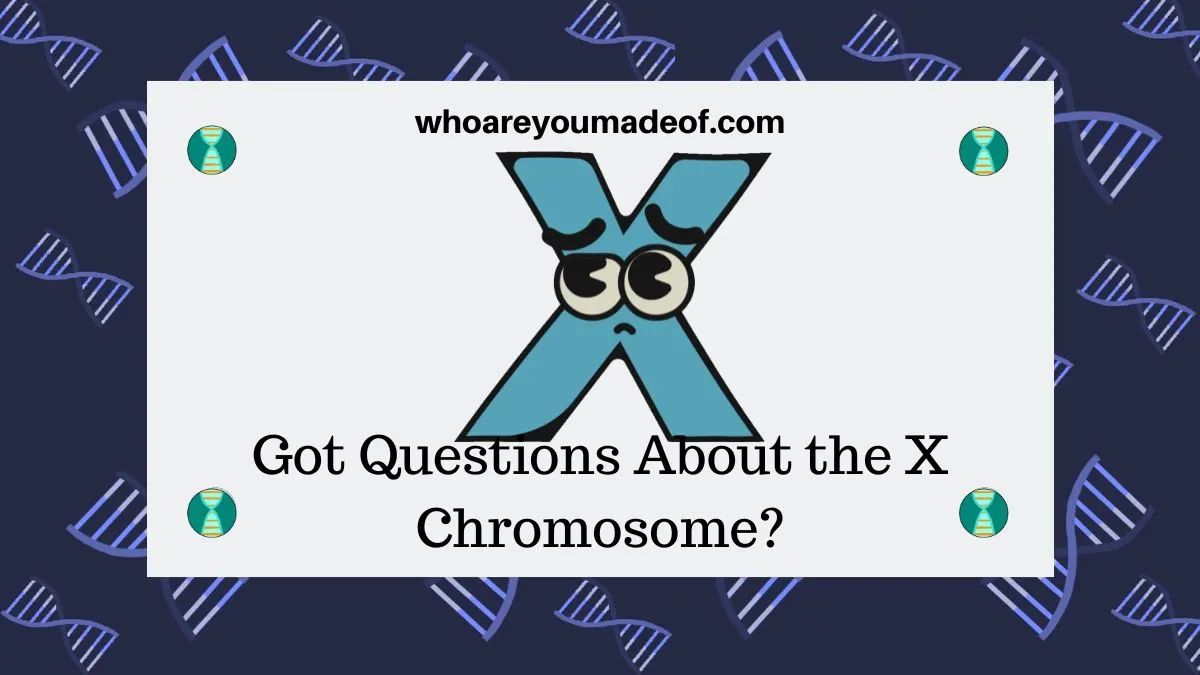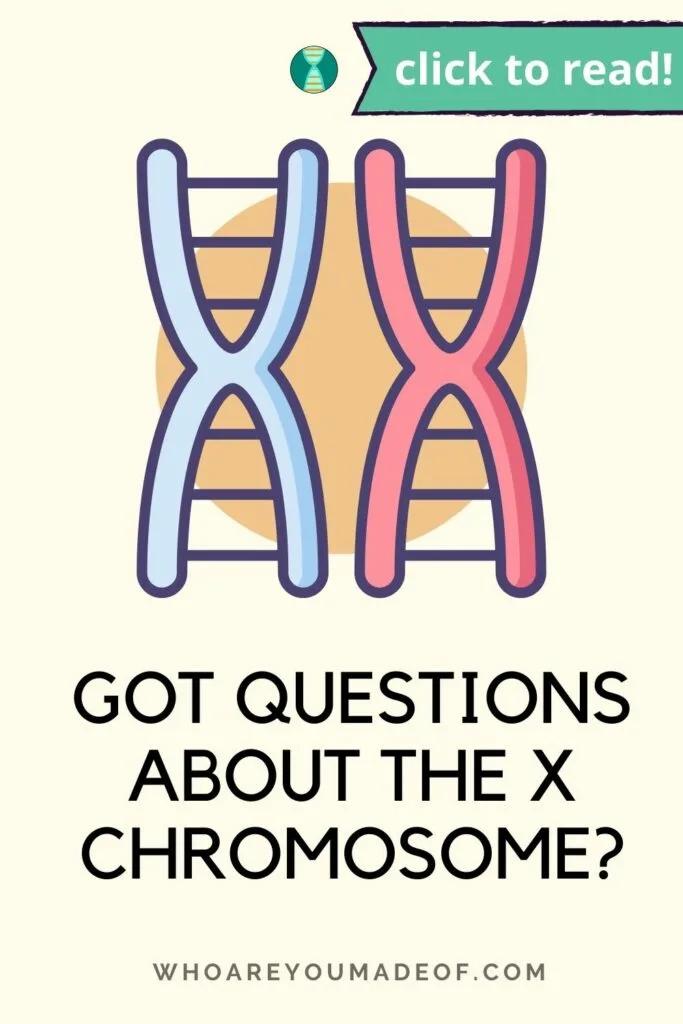Are you curious about the X chromosome? Maybe you are wondering if learning about your X DNA matches could help you learn more about your family history or how some of your DNA matches might be related to you.

In this post, I'll discuss some common questions related to the X chromosome and genealogy, including:
- What is the X chromosome, anyway?
- Does everyone have an X chromosome?
- What does it really mean when someone matches you on your X chromosome?
- Does NOT matching someone on the X chromosome mean anything?
- Can X DNA matches (or non-matches) be helpful in genealogy?
A lot of people who are just getting started in genetic genealogy (i.e. using DNA as a tool for genealogy research) avoid learning about the X chromosome because it seems confusing. While it's true that it takes a little more work to understand how the X chromosome is inherited and how it can be useful for genealogists, once you learn more about this topic, you will be happy that you did.
What is the X chromosome?
As you might remember from high school, we all have 22 numbered chromosomes and a sex chromosome. The sex chromosome is what determines our biological sex (i.e. male or female).
We have two "copies" of each chromosome, including our numbered chromosomes and our sex chromosomes. One copy of each of our chromosomes is inherited from our mother, and the other copy is inherited from our father.
Males will inherit an X and a Y sex chromosome. Their Y chromosome is inherited from their father, and a usually recombined X chromosome gets passed down from their mother.
Females, on the other hand, will have two X chromosomes - they get their father's entire intact X chromosome and an almost always recombined X chromosome from their mother.
Can the X chromosome recombine?
Recombination in relation to X chromosomes getting passed down from a female to their offspring means that the two copies of the X chromosome must "recombine" to make a new one. Since she has two copies of the X chromosome, her two X chromosomes get shuffled together to create a brand-new single X chromosome containing parts of each of the original two copies of the X chromosome.
She will pass this down to her child. If she has more than one child, the X chromosome that she passes down will be slightly different each time.
Males only have one copy of the X chromosome, and so when they pass it down to their male and female offspring, no recombination occurs. This is why we sat that males pass down an "intact" copy of their X chromosome.
It is possible for a female to pass down an intact chromosome, as well, meaning a complete copy of one of her X-chromosomes, just so you are aware. It's less common, however, because since she has two copies recombination is more likely.
Does everyone have an X chromosome?
So, yes, everyone - including men and women - will have an X chromosome. Men will only have one, however, while women will have two.
To recap:
- Males: XY (the X from mom, the Y from dad)
- Females: XX (full X from dad, recombined X from mom)
Note: The sex chromosome is why women can't take the Y DNA tests but men can. Females don't inherit Y DNA. A male inherits his Y DNA from his father, who inherited it from his father, who inherited it from his father, and so on and so on.
Y DNA testing can reveal information about the direct male line contained within the sex chromosome. Ladies, don't feel too left out. Both men and women can do mtDNA testing, which tests only the female line of a family.
What does it mean to have an X DNA match?
If you've done any reading at all about X DNA matches, you might have the sense that X DNA is complicated and confusing. To be honest, it is a little confusing and often complicated, but if you take the time to start to understand it little by little, you will be able to make some sense of it.
For example, let's pretend that our father has an X DNA match. He did not inherit any X DNA from his father (our grandfather), so we now know that the match is on our father's maternal side (our paternal grandmother).
This is huge - we have eliminated 50% of possible ways they could be related. We know that our paternal grandmother got one X chromosome from her dad and one from her mom, but we also know that dad's grandmother's dad only got his X DNA from his mother, eliminating one of our ancestral lines.
There are lots of great bloggers who have made very helpful "fan" charts that can help you figure out how to eliminate lines of your family that could possibly have passed down X DNA to you (or the person for whom you have an X match).
I haven't done so, so I'll link you to a good post by a blogger who has: "Unlocking the Genealogical Secrets of the X Chromosome" by Blaine Bettinger.
For those of you who are just starting off, some basics:
- Males who have an X DNA match automatically know that it is on their maternal side, and NOT on their maternal grandfather's father's lines of the tree
- Females who have an X DNA match can be sure that it is maternal or paternal, but NOT their paternal grandfather's lines of the family tree.
- Just like with autosomal DNA, smaller X DNA segments mean an ancestor from long ago, and larger X DNA segments can indicate a more recent common ancestor
I recommend starting off with your closest X DNA matches to see what you can work out. Use all of the other tools at your disposal, such as your "regular" (autosomal) DNA results, family tree information, and information obtained from communication with your DNA matches in order to work out your relationship. Once you've got the hang of X DNA as it pertains to your closer matches, you might feel ready to tackle more complicated X DNA issues.
What if I don't match someone on the X chromosome?
If you have compared your DNA with someone else's and you have determined that you share no DNA on the X chromosome, there are a few things that you could know for sure. You can read more about what it means to have no match on the X in my post "What Does No X DNA Shared Mean".
The post is helpful to those who have used the Gedmatch X DNA Comparison Tool, but also those who have used chromosome browsers on other sites to determine that they don't share X DNA with a particular person.
Conclusion
I hope that this post helped you get a good basic understanding of what the X chromosome really is, how it's inherited, and how it can be useful in your genealogy endeavors. If you have any questions about something that you read in this post, or if you would like to share your own experience using the X chromosome in your genealogy research, I would love to hear from you in the discussion below.
Thanks for stopping by!


elizabeth wyporowich
Monday 25th of January 2021
Greetings Full siblings share an entire X chromosome,so does that mean the blue is completely solid without any other color showing? Thank You for taking the time to read this email. Best Regards Liz